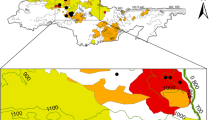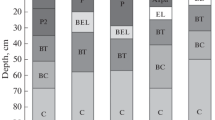Abstract
In two forest types in southern Tasmania, eucalypt rainforest (mixed forest) and eucalypt dry sclerophyll forest, surface soils (0–10 cm) from stands that had been clear-felled and burned between 1976 and 1979 were compared with those from uncut, unburned stands. Factors compared were total organic C, N, P, K, Mg, Ca, Zn, Mn; pH; exchangeable Ca, Mg, and K; cation exchange capacity; extractable P; soil phosphate buffering capacity; and N-mineralisation rates. Sampling started in April 1979 and ended in October 1980.
Within each forest type, soils from burned coupes had higher mean values for pH, exchangeable cations, percent base saturation, and nitrate-N produced during aerobic incubation, and had lower mean values for exchangeable acidity and ammonium-N produced during aerobic incubation than soils from unburned coupes. In mixed forest only, soils from burned coupes had higher mean values for extractable P and soil phosphate buffering capacity, and lower mean values for total organic C than those of unburned coupes. There were only small differences between burned and unburned soils in cation exchange capacity and ammonium-N produced during anaerobic incubation.
For each burned coupe in mixed forest, with increase in time since burning there was a decrease in pH, an increase in exchangeable acidity, and a decrease in rate of production of nitrate: no changes were detected in other factors. It is concluded that, for clay soils developed on dolerite, the nutritional status of soil in both forest types is probably improved by burning. The improvement lasts for more than 4 years in mixed forest and more than two years in dry sclerophyll forest. Only minor leaching of nutrients to below 10 cm in depth is likely to occur in either type.
Similar content being viewed by others
References
Anstett A 1956 Sur une méthode rapide de détermination du rapport C/N dans les sols, les amendements organiques et les végétaux. Proc. VI Congr. Sci. Sol (Paris), pp 693–699.
Austin R C and Baisinger D H 1953 Some effects of burning on forest soils of Western Oregon and Washington. J. For. 53, 275–280.
Banderis A, Barter D H and Henderson K 1976 The use of polyacrylamide to replace carbon in the determination of ‘Olsen's’ extractable phosphate in soil. J. Soil Sci. 27, 71–74.
Birch H F 1960 Nitrification in soils after different periods of dryness. Plant and Soil 12, 81–96.
Bremner J M 1965 Nitrogen availability indexes.In Methods of Soil Analysis. Ed. C A Black. Am. Soc. Agron. Madison, Wis., USA.
Brown I C 1943 A rapid method of determining exchangeable hydrogen and total exchangeable bases of soils. Soil Sci. 56, 353–357.
Chapman H D 1965 Cation-exchange capacity by ammonium saturation.In Methods of Soil Analysis. Ed. C A Black. Am. Soc. Agron. Madison, Wis., USA.
Cole D W, Crane W A J and Grier C C 1975 The effect of forest management practices on water chemistry in a second-growth Douglas-fir ecosystem.In Forest Soils and Forest Land Management. Ed. B Bernier and C H Winget. Les Presses de L'Université Laval. pp 195–207.
Edwards A B 1942 Differentiation of the dolerites of Tasmania. 1. J. Geology 50, 451–480.
Fowells H A and Stephenson R E 1934 Effect of burning on forest soils. Soil Sci. 38, 175–181.
Frankcombe D W 1966 The regeneration burn. APPITA 5, 127–132.
Gagnon J D 1965 Nitrogen deficiency in the York River burn, Gaspé Quebec. Plant and Soil 23, 49–59.
Gilbert J M 1959 Forest succession in the Florentine Valley, Tasmania. Papers and Proceedings of the Royal Society of Tasmania 93, 129–151.
Gilbert J and Cunningham T M 1972 Regeneration of harvested forests. 1. State forests in Tasmania. APPITA 26, 43–45.
Grier C C 1975 Wildfire effects on nutrient distribution and leaching in a coniferous ecosystem. Can. J. For. Res. 5, 599–607.
Grier C C and Cole D W 1971 Influence of slash burning on ion transport in a forest soil. Northwest Science 45, 100–106.
Harpstead M I and Brage B L 1958 Storage of samples and its effect upon the subsequent accumulation of nitrate nitrogen during controlled incubation. Soil Sci. Soc. Am. Proc. 22, 326–328.
Harwood C E and Jackson W D 1975 Atmospheric losses of four plant nutrients during a forest fire. Aust. For. 38, 92–99.
Helyar K R and Spencer K 1977 Sodium bicarbonate soil test values and the phosphate buffering capacity of the soils. Aust. J. Soil Res. 15, 263–273.
Holford I C R and Mattingly G E G 1979 Effects of phosphate buffering on the extraction of labile phosphate by plants and by soil tests. Aust. J. Soil Res. 17, 511–514.
Jackson M L 1958 Soil Chemical Analysis. Prentice Hall Inc., Englewood Cliffs, N.J.
Jorgensen J R and Wells C G 1971 Apparent nitrogen fixation in soil influenced by prescribed burning. Soil Sci. Soc. Am. Proc. 35, 806–810.
Kraemer J F and Hermann R K 1979 Broadcast burning: 25-year effects on forest soils in the western flanks of the Cascade Mountains. For. Sci. 25, 427–439.
Likens G E and Bormann F H 1974 Effects of forest clearing on the northern hardwood forest ecosystem and its biochemistry. Proc. First Internat. Cong. Ecol. The Hague.
Murphy J and Riley J P 1962 A modified single solution method for the determination of phosphate in natural waters. Analyt. Chim. Acta 27, 31–36.
Neal J L, Wright E and Bollen W G 1965 Burning Douglas-fir slash. Physical, chemical, and microbial effects in the soil. Forest Research Laboratory, Oregon State University Corvallis. Research Paper 1. pp 33.
Northcote K H 1971 A factual key for the recognition of Australian soils. 3rd Edn. CSIRO Adelaide. pp 123.
Olsen S R, Cole C V, Watanabe F S and Dean L A 1954 Estimation of available phosphorus in soils by extraction with sodium bicarbonate. USDA Circ. 937.
Ozanne P G and Shaw T C 1967 Phosphate sorption by soils as a measure of the phosphate requirement for pasture growth. Aust. J. Agric. Res. 18, 601–612.
Smith D W 1970 Concentrations of soil nutrients before and after fire. Can. J. Soil Sci. 50, 17–29.
Tarrant R F 1956 Effects of slash burning on some soils of the Douglas-fir region. Soil Sci. Soc. Am. Proc. 20, 408–411.
Tiller K G 1959 Distribution of some trace elements in soils developed on dolerite in Tasmania. Div. Rept. CSIRO Division of Soils, Adelaide. pp 33.
Wagle R F and Kitchen J H 1972 Influence of fire on soil nutrients in a Ponderosa Pine type. Ecology 53, 118–125.
Waring S A and Bremner J M 1964 Ammonium production in soil under waterlogged conditions as an index of nitrogen availability. Nature 201 (4922), 951–952.
Author information
Authors and Affiliations
Rights and permissions
About this article
Cite this article
Ellis, R.C., Lowry, R.K. & Davies, S.K. The effect of regeneration burning upon the nutrient status of soil in two forest types in southern Tasmania. Plant Soil 65, 171–186 (1982). https://doi.org/10.1007/BF02374648
Received:
Revised:
Issue Date:
DOI: https://doi.org/10.1007/BF02374648




